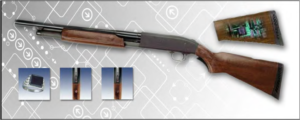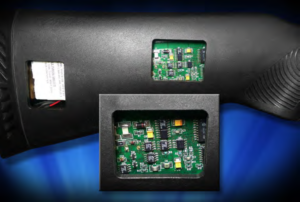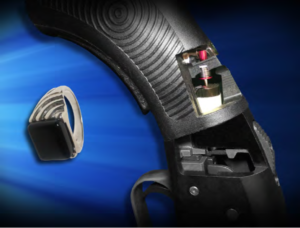Introduction
From Judge Dredd to James Bond, until recently much of the world believed smart guns or personalized guns were a thing of science fiction. The earliest smart gun research and development, however, occurred almost two decades ago; and one technology researched and developed for use in smart guns has been a part of general industry since the late 1970s.
A smart gun, or personalized gun, is a weapon containing more than standard mechanical parts as operating components used to fire, disable or report information on the weapon. Many smart guns are actually personalized firearms, which only permit authorized users to operate the weapon. Smart guns, or personalized firearms, automatically deactivate under certain circumstances, thus reducing the chance of accidental discharge or purposeful use by unintended persons [1].
In order to create a useful smart gun, the electronics embedded within the biometrically enabled smart gun must collect a biometric sample and match it to a registered user within a fraction of a second. The electronics used to create a biometric smart gun are significantly more complex than token-based technologies. Personal biometrics could make it nearly impossible to steal and operate a gun equipped with these technologies.
The world of smart guns is growing rapidly. Most smart guns are based in a handful of technology types, which are being implemented in handguns, rifles and semi-automatic styles of guns. The level of progress of the technologies varies widely from basic research to operational, commercially ready products. Solutions vary from an “add-on” to existing weapons to those that are factory integrated and cannot operate without their “smart” component.
Benefits/Negatives
Most of the smart technologies being developed for guns could reduce or eliminate accidental or intentional use of lost, misplaced or stolen guns. These weapons would not operate without their properly paired technology or persons. Components, such as radio frequency chips or biometrics fingerprints, would be required to operate the weapon. Smart guns that utilize GPS, cellular or other location-based technologies would stop the weapon from firing and would notify the owner or authorities with information on where and when the weapon was used. Suicide by weapon would also likely decrease, assuming the suicidal person is not an authorized user. Accidental shootings by children or others not intending to fire a live weapon could decrease, assuming they are not enrolled users.
Law enforcement worldwide could benefit from the above-mentioned general use items; however, they face additional issues, including the potential takeaway of a weapon. Weapon takeaways can happen in a number of ways, including a struggle with a perpetrator. If the officer has a smart gun this may prevent the perpetrator from taking action against the officer or innocent bystanders.
The U.S. military could take advantage of smart gun technologies. A basic weapon is always dangerous, and smart gun technology could create a level of protection. Stolen weapons have been an issue throughout military history because they can be used against our own military. Smart gun technologies could render the stolen weapons useless to the enemy. Additionally, smart gun technologies could simplify the command and control currently required when transporting military weapons by simply deactivating smart guns when not in use or being stored. As mentioned above, smart guns with GPS or other available reporting features would allow for the tracking of a lost, stolen, or misplaced weapon and could report on when and where a weapon is fired.
The government understands the costs to create a smart gun is no small feat, as evidenced by the Report to the President Outlining a Strategy to Expedite Deployment of Gun Safety Technology which states, “Firearms manufacturers will need to decide whether to make similar investments here. To achieve the innovations that the President seeks, one or more companies must decide that the benefits of enhanced gun safety technology exceed the costs of researching, developing, and marketing such technology [2].”
This statement does not note the amount of time required to determine any number of factors that must be considered when developing a smart gun [2].
Development Factors
The Department of Homeland Security Science and Technology Directorate already met with law enforcement agencies and developed the following potential issues and considerations to be included as specifications for smart guns as they are developed [2]:
Reliability (Priority Requirement)
The largest factor in developing a smart gun is reliability. A firearm must operate the moment it is needed, and with a smart gun, not at any other time or with anyone not authorized. This is a strong situation to create. Home protection weapons may go years without being touched, but are expected to (and usually do) operate properly the moment when needed. All smart guns currently used rely on new technology.
This is an issue because no new technology is perfect: dropped calls, dead batteries, computer malfunction or failure, etc. In most cases, none of these things result in harm or even death, but when a weapon is being used for protection, by the local law enforcement, or a soldier it must. When something is made of multiple components, it is only as reliable as the least reliable piece used in its construction. This must be considered for all forms of smart gun development. The more types of technology developed into a smart gun, the more potential for situational failure.
Durability
Durability and reliability are strongly coupled. Guns, which have been around for centuries, are one of few products that have essentially the same operating function as a century or two ago. While guns can be used indoors, they are more likely used outdoors, exposed to elements, for hunting and in war. Not many technology components are developed for use in these rugged environments, and when developed, they are normally costly.
Permitting Multiple Users
Depending on whether a weapon is for use by a family, a law enforcement agency or even soldiers, one consideration is the number of authorized users, which will vary depending on the needs of the users. It will also have an affect on the type of technology developed, the computing technology required, the battery and battery life in operation.
Physical Characteristics of Firearm
Smart gun technology concepts come in many forms; some are “add-ons” while other concepts create a new gun that is only “smart” and never to be used without an authorized user. Add-on technologies operate on or inside existing guns, such as trigger guards or replacing interior firing mechanisms with user-authorized technology.
Ease and Predictability of Use
Ease and predictability of use involves how natural the operation of the smart gun is to a normal user. Most handguns are simple to operate, though a smart gun must consider more as it is offering more to a user beyond firing a gun. One must control the authorized users, operational component configuration, charging and potentially much more. This could easily contain the most widely varying options in development.
Training
Training links to nearly every aspect mentioned in the list above. Users would have to be trained on the limitations, reliably and durability first. How and who can operate the weapon? What it is that is smart on the smart gun? Lastly, how to use the weapon would all be a part of training.
Maintenance and Repair
Current guns have an often-overlooked maintenance schedule that rarely affects the operation of the weapon. This would likely drastically change with smart weapons. Maintaining a charge to battery operated components, preventing circuit corrosion or any number of other items will be dependent on the design of the smart gun.
Adversarial Compromise of Technology
The potential compromise of technology can be achieved in many ways, some less obvious than others. It could include the leaking of how the technology is built, thus allowing for potential hacking of the circuits used. This could include the removal of the technology and insertion if required of other technology.
External Devices
Some smart technologies include the need for paring devices for operation. Other items include the need for a battery charging, or a computer or smart phone application in order to add or remove authorized users.
Power Failure
Power failure, or component failure, must be avoided at all costs. Low power consuming components, long lasting batteries, moving functions that can be executed off the device should be considered.
Speed of Operation
Any smart gun technology should be seamless and as fast as a weapon without the added technology. This concept will reduce the amount and type of technologies that can be designed into a weapon [2].
Technologies at Play
The National Institute of Justice Report: A Review of Gun Safety Technologies has a comprehensive list of all major efforts in the smart gun arena up until its publishing in 2013 [1]. None of the smart guns and technology researched were developed or led by the federal government, all were by private industry manufacturers. The report identified many projects and technologies, including those currently deemed commercialized and ready to be used, which are summarized below.
Biometrics technologies use unique physiological features to identify a person. In the case of smart gun technologies, a biometric could be used to authorize a user. Biometrics include fingerprints, faces, voices, veins and many other features; however, not all of these biometrics can easily be used to authorize use of a smart weapon.
Fingerprint technologies would require a user to place a finger on a sensor. The sensor or fingerprint reader would need to be placed strategically on the weapon in order for a user to not have to consciously think, but inherently place their finger on the sensor when handling the weapon for use. In other words, the sensor is needed somewhere on the grip where the finger would normally rest. A fingerprint would have to be scanned and match to a registered user in a fraction of a second. If matched, the weapon is enabled; otherwise it remains in a locked non-operable default state.
Kodiak Industries Intelligun. In 2012, Kodiak Industries developed the Intelligun as a biometrically enabled smart gun. The system implements a fingerprint locking system installed in the handle of a standard 1911 .45 caliber handgun. Through a patented design, Intelligun unlocks the 1911 within a fraction of a second for registered, authorized users. The Intelligun system was designed as an add-on system targeted at sending the firearm to Kodiak or to a Kodiak licensed firearm dealer for installation [1].
Safe Gun Technologies. In 2013, Safe Gun Technologies developed a prototype fingerprint-based smart gun. The goal was to create a retrofit kit for factory or authorized dealer installation (an add-on). The prototype was developed on a Remington 870 shotgun, which is used by general consumers and law enforcement alike [1].
Palm print technologies could also authorize a user by implementing a spectroscopic or optical technology based in the slight variances in skin, or perhaps an image based technology that would look at the patterns in the veins of a hand. This technology typically operates in the visible or near infrared spectrum and would compare a registered user’s optical data to that of the person holding the weapon. There are no currently known efforts in palm prints.
Dynamic handgrip recognition is authentication based on the human grasping behavior. DGR is a combination of physical and behavioral characteristics collected and measured over a period of time. This method is different because it is not based on an inherent physical trait like physical biometrics, such as fingerprints. DGR’s hypothesis is that grasping behaviors are unique and could be measured and identified over time. Attributes under consideration are hand size, the hand’s geometric structure and the pressure or strength placed on a grip of a weapon over time[1].
New Jersey Institute of Technology’s Childsafe Weapons Project. NJIT Professor Donald Sebastian has led the research behind DGR. NJIT research notes that the way in which a person squeezes the firearm while pulling the trigger is a unique and measurable pattern of events. NJIT created a prototype handgun with 32 sensors to measure DGR pressure. DGR testing has been limited to study by NJIT using a small sample size. However, DGR has only been researched on the NJIT prototype, which achieved a high recognition rate based in a small sample size [1]. Independent research on DGR, both on the validity of the recognition method and with a more representative subject sample size, is needed before confirming DGR as a suitable authentication method [3].
Static handgrip recognition is a potential biometric authentication method based on the human grasping behavior much like dynamic handgrip biometrics. However, instead of using the dynamics of grasping, it exploits the static pressure pattern exerted on the grip of the gun to determine if a person is who they presume to be. This method is based upon a person performing a single action once and its repeatability for a unique, measurable biometric at a single point in time.
Token-based technologies require an item, such as a card, watch or ring, to operate the system. These tokens are all carried or worn on the body; however, other types of tokens such as a microchip could be (theoretically) implanted into an authorized operator. The former would require that a user remember to wear or have the token with them, but in the case of an implant, a user would only need to have the weapon. Watches, rings or cards are all susceptible to theft, and a stolen token would turn an unauthorized user into an authorized user by simply having both the token and the associated weapon. Layering additional security features into a weapon, such as a personal identification code or a biometric fingerprint, could potentially mitigate unintended use.
Radio frequency identification token-based technologies are wireless, non-contact radio frequency based electromagnetic fields that transfer information in support of automatically identifying and/or tracking a token or tags attached to an item. RFID technologies were developed in the late 1970s to track livestock [4], and now exist in multitudes of general consumer products, such as anti-theft devices in department stores.
Many of these tags do not require a battery to operate and are powered in short ranges by magnetic fields via electromagnetic induction. RFID technologies use readers and tags (tokens) which can either be passive (non-powered) or active (powered) depending on implementation. When used in a weapon, token-based RFID technologies create a communication link between the weapon and the token. Normally, a coded signal is transmitted from the weapon (powered) to the token (generally passive). The code potentials lie within the billions of unique IDs. Once a response is made, the weapon is authorized to be fired [1].
As previously noted, this technology is not line-of-sight based, enabling the user to wear gloves or the token to be embedded in a sub-dermal implant. The negative of RF technologies is that they are subject to interference dependent on many factors, such as operating frequency and range. However, short range uses, such as for smart weapons, would be less susceptible to interference. A user would want a token-to-weapon system to operate from a few inches away, at most, and within a fraction of a second; something that RFID technologies can easily do.
Armatix Smart System. Armatix developed the iP1 pistol from the ground up as a smart gun. It is not available as a standard mechanical operating gun. The system includes the iP1 and a wrist worn transponder, the iW1. Communication between the two authorizes the weapon to fire. Active RFID is used to establish communication and authorization between the components via near-field communication protocols. Authorization completes if the correct personal identification number is entered into the transponder. The smart system is a commercially available system [1].
Colt Smart Gun. Colt began developing a prototype 40 caliber pistol in 1997. The system was designed like the Armatix Smart System without the PIN. Development ended in 2000 after contracts with the National Institute of Justice were completed. Gun development stopped due to pressures from the general user community as well as the National Rifle Association [1].
iGun™ M-2000. The iGun™ M-2000 shotgun (Figures 1 and 2) is likely the first commercialized smart gun. iGun was developed in 1998 and leveraged a patented ultra-low frequency RFID technology. An operator is required to wear a passive RFID ring (Figure 3), which holds an inert, non-powered chip that, when energized, sends a specific code to the weapon. The signal is sent when a user handles the weapon in a regular gripping method, which depresses a lever in the stock. A signal is generated and if a matching signal is received and matched, a second verification is requested. Only after matching a second time does the firearm enable firing. iGun’s intention is to have operation be transparent to any user. The iGun system is a factory integrated weapon and was not intended to be available as an add-on or a modification [1].

Figure 1. iGun’s M-2000. (Image courtesy of Jonathan Mossburg/Released)

Figure 2. View of the internal components of the iGun, including the battery and circuit board, enlarged view (Image courtesy of Jonathan Mossberg/Released)

Figure 3. RFID chipped ring and iGun internal disabling solenoid pictured. (Image courtesy of Jonathan Mossberg/Released)
Triggersmart. Ireland-based Triggersmart uses high-frequency RFID for authorization between weapon and token. Triggersmart began smart gun research and development in 2010 on a handgun. Triggersmart built three demonstration models on a shotgun, handgun and rifle. Due to legal ownership status changes in Ireland, the system now targets an MP5. Triggersmart is considered a factory add-on as it simply replaces the factory installed lower receiver with the one developed [1].
Ultrasonic token-based technologies require the operator to wear the token. The token would emit an ultrasonic coded signal that, when received by the weapon, allows the weapon to fire. Ultrasonic frequencies operate in a range that is too high for humans to hear and could be used to determine weapon proximity. When the weapon is too far away or within a specified range, the weapon automatically activates or deactivates.
FN Manufacturing’s Secure Weapon System. FN Manufacturing began development of the Secure Weapon System in 2001. The system was based in ultrasonic with a handgrip switch used to activate the system. FN believed in the proximity capabilities of ultrasonic, but the system never made it past pistol prototype stage. FN later looked to RFID before abandoning its smart gun research.
Future/Now
Gun Guardian does not insert technology in the mechanical components of the gun, and instead secures a firearm by restricting access to the trigger with a manually closed, spring-loaded shield. The shield will only uncover the trigger when one of two items occurs: the correct biometric signature is read via the fingerprint reader or the correct security code is entered into a cipher lock [5].
Once the biometric signature is verified or correct security code is entered, the shield automatically and instantaneously retracts allowing access to the trigger of the firearm. Gun Guardian is an add-on solution that attaches to the weapon even when unlocked.
Additionally, Gun Guardian has an optional GPS tracker, which allows the firearm to be located in the event of misplacement or theft. The tracker has two activation options: 1) it will only transmit a signal while in the locked position, which ensures soldiers cannot be tracked while on patrol; 2) it gives off a continuous signal which allows the firearm to be located at any time.
Gun Guardian developed and fielded an initial pre-production prototype for operational testing. A greater level of reliability occurs with this style of solution as the core mechanics of the gun are preserved, but a dual level of access is achieved in the case of a failure or need to use one over the other (i.e., very high reliability).
The government created a short-term timeline to partner with a greater number of state, county and municipal law enforcement agencies to create specific operating parameters for which they would require to purchase a smart gun [2].
Without a doubt smart technologies can and will be implemented into weapons, but what form will they take? How long will development take? Can they be reliable in high stress situations? When a weapon is needed to defend life, it has to work. ■
References
1. Greene, M. (2013 June). A Review of Gun Safety Technologies. U.S. Department of Justice – Office of Justice Programs – National Institute of Justice. Retrieved from https:// www.ncjrs.gov/pdffiles1/nij/242500.pdf (accessed July 15, 2016).
2. Report to the President Outlining a Strategy to Expedite Deployment of Gun Safety Technology (2016). Departments of Justice, Homeland Security and Defense, retrieved from https://www.whitehouse.gov/sites/default/files/docs/final_report-smart_gun_report.pdf (accessed July 15, 2016).
3. Information based on personal interviews conducted by the author, Jonathan Hayes, around April 2013.
4. Roberti, M. (2005 January 16). The History of RFID Technology. RFID Journal. Retrieved from http://www.rfidjournal.com/articles/view?1338 (accessed June 14, 2016).
5. Gun Guardian – Our Products (2016), retrieved from http://www.gunguardian.us/#!our-products/iueun (accessed June 15, 2016).
Jonathan Hayes obtained a master’s degree in software engineering as well as bachelor’s degrees in computer and electrical engineering from West Virginia University. He has worked almost two decades in the private sector, supporting government contracting for the Department of Defense, the Department of Justice and the Department of Homeland Security. The last 11 years, Hayes primarily focused in biometric research, development, testing and evaluation. Hayes supports the West Virginia University Innovation Corporation as a biometric subject matter expert.


